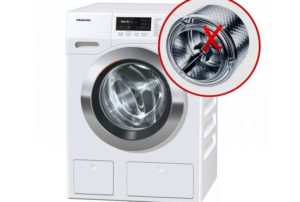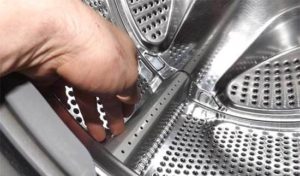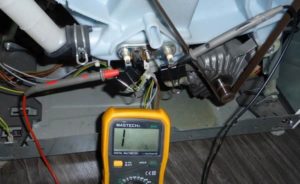The drum in the washing machine does not spin well
 The drum is one of the main elements of an automatic washing machine. If it malfunctions, washing clothes becomes impossible. Having diagnosed a breakdown of this kind, you should as soon as possible figure out why the drum is spinning tightly and what caused it. So, let's discuss the main reasons and point out methods for solving the problem that has arisen.
The drum is one of the main elements of an automatic washing machine. If it malfunctions, washing clothes becomes impossible. Having diagnosed a breakdown of this kind, you should as soon as possible figure out why the drum is spinning tightly and what caused it. So, let's discuss the main reasons and point out methods for solving the problem that has arisen.
The most common causes of the problem
First, it’s worth understanding why the washing machine does not rotate the laundry well when washing. It is after a complete diagnosis of the machine that you can determine which path should be taken to eliminate the malfunction. The drum may stop spinning due to several factors.
- Washer overload. For each automatic machine, the maximum permissible weight of dry laundry loaded into the drum is determined. Most modern devices are equipped with special sensors that determine the weight of things. It is because of overload that the intellect may refuse to start a program launched by the user.

- Damage to the drive belt. In such a situation, if you turn the drum by hand, it will spin freely, but at the same time the washing machine itself will not be able to rotate it. The drive belt tends to wear out and lose its properties. It is also possible that he simply jumped off his seat.
- Problems with motor brushes. In machines equipped with commutator motors, brushes are one of the most vulnerable points. If you have been using such a machine for a long time, and the electric motor has not received the necessary maintenance, it is better to check the wear of the brushes and, if necessary, replace the part.In most cases, after replacing the motor brushes, the machine returns to normal operating mode.
- Control module failure. Failure of the electronic unit is considered one of the most serious problems; in order to return the machine to functionality, you will have to reflash it or install a new module. It is better to entrust the elimination of such a malfunction to a specialist.
- Failure of the electric motor. If the drum rotates unevenly, or even stands still, the engine may have fallen off. A failure may occur due to a short circuit or damage to motor components. Engine repair work is classified as complex, so doing it yourself is not recommended.
It is precisely such malfunctions in the automatic washing machine system that can lead to problems with drum rotation.
Some causes can be identified and eliminated on your own; more serious damage can be repaired by a qualified technician.
We carry out initial diagnostics
Any housewife can carry out initial diagnostics of the system. First of all, you should understand the permissible weight of things to be placed in the drum. Usually information about the maximum load is available on the machine body or in the instructions. If the weight of the laundry does not exceed the norm, you need to look for the problem further. Check if the sunroof locking device has worked. Perhaps the door did not close tightly, and that is why the machine does not start the program and does not rotate the drum.
Try turning the drum by hand. If it rotates freely manually, but stands still when you start the washing program, most likely the washing machine’s electric motor or its control module has broken down.
In some cases, the movement of the drum may be blocked by foreign objects caught in the cavity between the metal rim and the tank of the automatic machine. If during the inspection no foreign bodies were found in the cavity, it is worth moving on to diagnosing other elements of the washer.
Inspect the heating element; if the heating element is faulty, the drum may also not spin. This will be due to the fact that intelligence will block the entire washing process. Also examine the engine belt. The drive belt may have broken or fallen off its seat. Install it correctly or replace it with a new one.
Worn bearings can also be to blame. To eliminate this possibility, you will have to disassemble the washing machine and see what condition the components are in. If the machine has served you faithfully for several years, and the bearings have not been maintained, you will have to replace the elements.
Let's check the motor brushes
If, after examining the engine brushes, you find that they are worn out, it is better to replace the elements. To choose the right brushes for the electric motor, you need to know the type and model of your washing machine’s engine. This data can be obtained by examining the markings on the electric motor.
The algorithm for replacing brushes is quite simple; you need to remove the old elements from the motor and install new components, securing them with bolts. After installing the brushes, rotate the engine by hand to understand the tightness of their fit to the engine.
When rotating, the device should make a slight clicking sound.
Checking and changing the heater
In a situation where the drum is “jammed” and the intelligence does not start the selected washing program, it is necessary to check the heating element.The heating element may have stopped functioning. Removing the part from the housing is quite easy; you just need to find its location, reset the wiring and pull out the heater. When purchasing a replacement heating element, make sure that the analogue exactly matches the model of your washing machine.
If the heating element is located in the rear part of the case (on Samsung, Whirlpool, Zanussi, Ardo, ElGi washing machines, etc.), you must:
- move the machine away from the wall;
- Unscrew the bolts holding the back wall.
 The heating element will be located in the lower part, directly under the SMA tank. In machines of the brands Bosch, Siemens and AEG, access to the part can only be obtained from the front side of the case. To reach the heater from the front:
The heating element will be located in the lower part, directly under the SMA tank. In machines of the brands Bosch, Siemens and AEG, access to the part can only be obtained from the front side of the case. To reach the heater from the front:
- remove the powder receptacle from the housing;
- Unscrew the screws holding the main control panel, carefully place the panel on the top cover of the washing machine;
- Unfasten the latches holding the lower trim panel. This will give you access to the drain filter;
- Unscrew the garbage filter and drain the water remaining in the system;
- open the clamp holding the hatch cuff, pull the metal ring out of the car;
- insert the rubber seal inside the drum;
- Unscrew the bolt holding the front wall of the case and carefully remove it.
After carrying out the described actions, you will approach the heating element located under the SMA tank. Before removing and replacing the heating element, you must check its functionality. A multimeter will be useful for this.
Disconnect all wiring of the heating element, switch the tester to resistance measurement mode and attach the probes of the device to the heater contacts. The multimeter screen should display a value of 20-30 ohms.If the resistance value is higher or lower than normal, the heating element must be replaced. For this:
- loosen the nut on the central bolt;
- push the element inside the tank;
- carefully remove the heater from the housing by prying it off with a screwdriver;
- insert a working element into the socket;
- tighten the fastening nut;
- Connect the wires to the contacts of the heating element according to the previous diagram.
If the reason for the drum “standing still” lay precisely in a malfunction of the heater, then these actions should return the SMA to full functionality. It is very important to follow safety precautions when carrying out repair work and do not forget to disconnect the machine from the network and utilities.
Something jammed the drum
When it seems to you that the drum is moving very hard or is moving in certain jerks, periodically “freezes” in place, and in addition to this you hear strange knocks and noises from the body, there is probably a foreign object stuck between the walls of the drum and the washer tank.
To check your guess, you need to gain access to the heating element of the machine and remove the heater from the body. Then, using a flashlight, look into the resulting hole, so you can see the foreign body stuck in the cavity.
Fixing a similar breakdown in top-loading machines
If the drum spins tightly in the “vertical”, perhaps the root cause of this is open flaps in the tank. If the door latch accidentally opens at the bottom of the tank instead of at the top, the drum may become wedged, causing it to stop spinning. There are two ways to solve the problem:
- Without disassembling the washer, turn the drum with a hook that you can make from wire with your own hands.To do this, prepare a steel wire of small diameter and bend its end, making a kind of hook. Insert the wire into the hole in the drum and try to close the doors in the tank and spin the drum.
- Having gained access to the doors, remove the front or bottom wall of the washing machine body. To do this, turn off the power to the unit, disconnect it from the house communications, place the machine on its side, and remove the tray. The lower counterweight should then be removed. You can stick your hand into the resulting hole and slam the opened doors.
Some users may find it more convenient to close the doors through the hole in which the heating element is installed. To do this, you will have to remove the side wall of the case and take out the heater, then close the doors and rotate the drum. If the sashes are bent, then closing them simply won’t work; you need to seek the help of a professional repairman.
Interesting:
Reader comments
- Share your opinion - leave a comment





















Add a comment